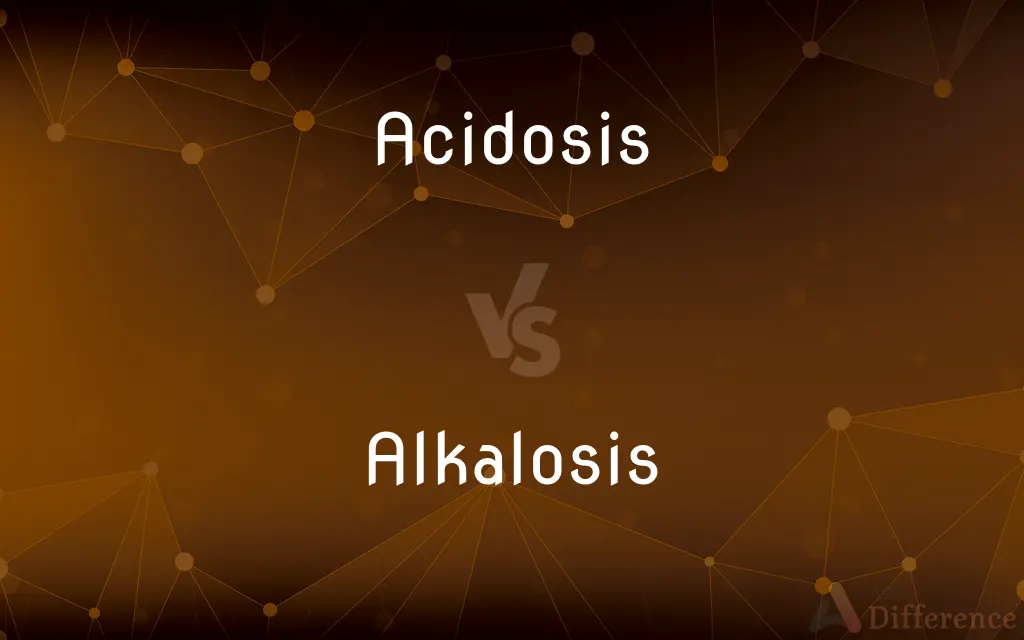Acidosis vs. Alkalosis — What's the Difference?
By Urooj Arif & Maham Liaqat — Updated on March 25, 2024
Acidosis is a condition where the body fluids contain too much acid, causing the blood pH to fall below 7.35, while alkalosis is a condition where there is too much base in the body fluids, raising the blood pH above 7.45.

Difference Between Acidosis and Alkalosis
Table of Contents
ADVERTISEMENT
Key Differences
Acidosis and alkalosis are both imbalances in the body's acid-base homeostasis, but they occur due to opposite abnormalities. Acidosis results from an accumulation of acid or a significant loss of bicarbonate, leading to a lower pH in body fluids. This can be caused by factors like respiratory failure, diabetes, or kidney disease. Alkalosis, conversely, arises from an excess of bicarbonate or a loss of acid, elevating the body's pH levels. Causes can include prolonged vomiting, hyperventilation, or excessive bicarbonate intake.
Symptoms of acidosis can include fatigue, confusion, shortness of breath, and lethargy, reflecting the body's distress in a too-acidic environment. Alkalosis symptoms might manifest as muscle twitching, hand tremor, light-headedness, and numbness or tingling in the face, hands, or feet, indicating the body's struggle with excessive alkalinity.
The treatment for acidosis may involve addressing the underlying cause, such as administering insulin for diabetes-induced acidosis or providing supplemental oxygen for respiratory acidosis. Alkalosis treatment also targets its root cause, which might include correcting electrolyte imbalances or controlling breathing patterns in cases of respiratory alkalosis.
The body's pH level is a critical factor in overall health, influencing enzyme functions, electrolyte balance, and oxygen delivery. Both acidosis and alkalosis can have serious health implications if not properly managed, underscoring the importance of maintaining acid-base balance through proper medical care and lifestyle choices.
Comparison Chart
Causes
Respiratory failure, diabetes, kidney disease
Prolonged vomiting, hyperventilation, excessive bicarbonate intake
ADVERTISEMENT
Types
Metabolic acidosis, Respiratory acidosis
Metabolic alkalosis, Respiratory alkalosis
Symptoms
Fatigue, confusion, shortness of breath
Muscle twitching, tremor, light-headedness
Treatment Focus
Addressing underlying causes, restoring balance
Correcting root cause, managing symptoms
Physiological Impact
Impaired enzyme function, electrolyte imbalance
Altered oxygen delivery, muscle function
Compare with Definitions
Acidosis
Treated by addressing the root cause.
Administering insulin for diabetic acidosis.
Alkalosis
Arises from either respiratory or metabolic imbalances.
Panic attacks with hyperventilation may lead to respiratory alkalosis.
Acidosis
A condition marked by excessive acid in body fluids.
Untreated diabetes can lead to metabolic acidosis.
Alkalosis
Treatment aims at correcting the underlying issue.
Electrolyte supplements may be used for treatment.
Acidosis
Symptoms include lethargy and confusion.
Patients with acidosis often report feeling unusually tired.
Alkalosis
Symptoms involve muscle twitching and dizziness.
Alkalosis patients may experience hand tremors.
Acidosis
Can result from respiratory or metabolic issues.
Severe asthma may trigger respiratory acidosis.
Alkalosis
Influences oxygen delivery and muscle function.
Alkalosis can impair the body's ability to utilize oxygen efficiently.
Acidosis
Affects the body's enzyme functions.
Acidosis can disrupt normal metabolic processes.
Alkalosis
A condition characterized by too much base in the body.
Excessive vomiting can cause metabolic alkalosis.
Common Curiosities
What is the normal pH range for human body?
The normal pH range is between 7.35 and 7.45.
Can acidosis and alkalosis be life-threatening?
Yes, if severe and untreated, both conditions can be life-threatening.
How is the cause of acidosis or alkalosis determined?
Diagnosis often involves body tests to analyze pH, carbon dioxide, and bicarbonate levels, alongside assessing symptoms and medical history.
Can diet affect acidosis and alkalosis?
Yes, diet can influence these conditions, especially in metabolic acidosis or alkalosis, through the intake of acidic or alkaline foods.
What is the role of bicarbonate in the body?
Bicarbonate acts as a buffer to maintain the body's pH within its normal range.
How do the kidneys and lungs regulate acid-base balance?
The kidneys regulate acid-base balance by excreting acid or bicarbonate as needed, while the lungs adjust carbon dioxide levels through breathing.
What lifestyle changes can help manage acidosis and alkalosis?
Lifestyle changes may include dietary adjustments, managing stress, and treating underlying conditions that contribute to the imbalance.
Is it possible to have both acidosis and alkalosis at the same time?
While rare, complex conditions can lead to mixed acid-base disorders, requiring careful medical evaluation and management.
Can breathing techniques affect acid-base balance?
Yes, controlled breathing can help manage respiratory alkalosis by regulating carbon dioxide levels.
Are there any preventive measures for acidosis and alkalosis?
Preventive measures focus on managing conditions that can lead to these imbalances, such as diabetes, and maintaining a healthy lifestyle.
Share Your Discovery

Previous Comparison
Silage vs. Hay
Next Comparison
Allegiance vs. DevotionAuthor Spotlight
Written by
Urooj ArifUrooj is a skilled content writer at Ask Difference, known for her exceptional ability to simplify complex topics into engaging and informative content. With a passion for research and a flair for clear, concise writing, she consistently delivers articles that resonate with our diverse audience.
Co-written by
Maham Liaqat














































